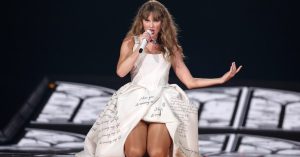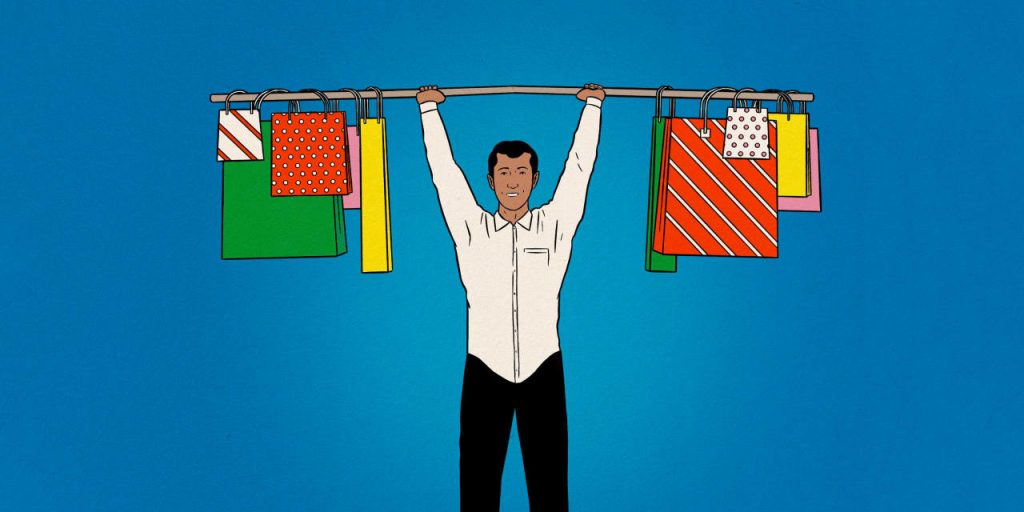After two years of sustained spending, rising interest rates, and punishing inflation, American consumers are still on a roll. Consumer outlays account for about 70% of the U.S. economy, and the Covid-era spending spree has kept gross domestic product on a path of surprisingly strong growth. Real GDP grew nearly 5% in the third quarter, according to early estimates, the best showing since the fourth quarter of 2021.
The spending boom is bound to lose some vigor as savings erode and higher rates bite: Real personal-consumption expenditures are on track to rise 2.2% this year, according to FactSet estimates, below last year’s 2.5% growth rate and 8.4% growth in 2021. Yet relatively healthy household finances, a resilient labor market, and substantial housing wealth suggest that consumers still have plenty of firepower and that the U.S. economy will avoid a recession next year.
“The consumer has the potential to keep the U.S. economy afloat for quite some time,” says Olu Sonola, head of U.S. regional economics at Fitch Ratings.
Jobs and Spending
A healthy labor market has been the driving force behind consumer spending, including a 3.1% annual jump in retail sales in the past three months. With the unemployment rate at 3.9%, near historic lows, the majority of working-age Americans are earning regular paychecks. “Consumers are spending so much because of what’s happening in the labor market,” says Wendy Edelberg, director of the Hamilton Project at the Brookings Institution.
The Covid-19 pandemic, which first hit the U.S. in February 2020, sent much of the economy into a tailspin, including the labor market. Yet in 2021, with Covid vaccines on the market and government stimulus flowing, growth in nonfarm payrolls exploded upward to average a gain of 605,000 a month.
Although job growth slowed last year to a monthly average gain of 399,000, that was still more than three times the estimated level of 100,000 monthly gains needed to keep the economy on an even keel. Job growth has normalized further this year, but remains elevated at a three-month moving average of 204,000 as of October.
Job openings, meanwhile, are still elevated relative to prepandemic levels, with the Bureau of Labor Statistics reporting 9.6 million vacancies in September. That’s down from the high of more than 12 million openings in March 2022 but above the 6.7 million vacancies recorded at the end of 2019. There are still 1.5 jobs available for every unemployed person seeking work.
Plentiful openings and low unemployment continue to put upward pressure on worker pay. Compensation costs for civilian workers climbed 4.3% in the third quarter on a year-over-year basis, according to the latest Employment Cost Index. While that is below the 5.1% peak growth rate recorded in the second quarter of 2022, wage gains have outpaced inflation since May 2023. Since wages account for the bulk of Americans’ total income, pay gains have an outsize impact on financial security and spending power.
Given falling birthrates, lower immigration, and the growing number of baby boomers entering retirement, many labor economists believe that tight employment conditions will persist. The BLS projects that total employment will grow only 0.3% annually over the next decade, far below the 1.2% annual growth rate recorded from 2012 to 2022.
“As long as you don’t have enough children and immigrants coming in—and if you don’t have policies that help parents stay in a labor market, and especially women—then you’re going to be challenged with labor as the baby boomers retire,” says Dana Peterson, chief economist at the Conference Board.
Household Finances
High spending levels haven’t yet compromised most household balance sheets, according to recent data from the Federal Reserve Banks. In part, that’s because Americans’ wealth grew by 37% from 2019 to 2022, according to the Fed’s latest Survey of Consumer Finances.
Rising rates of homeownership, an increase in home values, a rising stock market, and higher incomes all helped drive up household net worth. More significantly, consumers got a helping hand from the government in the form of an unprecedented $814 billion of stimulus payments supplied to U.S. households to combat the economic fallout from the Covid pandemic. As a result, households’ real median net worth grew to $192,900 by the end of 2022, up from $141,100 in 2019—the largest three-year increase on record.
In all, Americans generated $2.1 trillion in excess savings during the pandemic, estimates the Federal Reserve Bank of San Francisco. Many households further improved their financial footing by taking advantage of low interest rates and extra savings to pay down debt. For example, the share of credit-card holders who carried a balance declined from 50% to 45% from April 2020 to December 2021, according to the U.S. Government Accountability Office. And about a third of outstanding home mortgages were refinanced in this period.
Although household indebtedness has risen since then, only 3% of Americans’ outstanding debt was in some stage of delinquency at the end of September, according to the latest data from the Federal Reserve Bank of New York. By comparison, delinquency rates hit a record of nearly 12% in 2009 and stood at 4.7% at the end of 2019.
Moreover, consumers used an average of only 24.1% of their available credit-card allowances as of the third quarter, still below the prepandemic level of 24.6%, according to TransUnion. Both modest delinquency rates and low credit utilization are key indicators of financial health and spending power. Current measures of consumer debt and borrower distress “don’t look worrying,” Edelberg says.
Just 9%, or about $190 billion, of excess pandemic savings remained as of this past June, the San Francisco Fed estimates. Yet consumer spending has persevered. In addition to the aforementioned job-market strength, cooling inflation has helped reverse some of the previous loss of purchasing power. In particular, gasoline prices have fallen this year, while food-price inflation has decelerated.
Confidence Problem
Ironically, Americans’ confidence in their personal financial situation and the broader economic outlook has been persistently grim in recent years, according to various sentiment surveys. Based on the University of Michigan’s Consumer Sentiment Index, Americans’ confidence has fallen sharply since the start of the Covid pandemic and now stands at the same levels as those recorded during the 2008-09 financial crisis.
While confidence readings hinted at more optimism earlier in the summer, the index has trended down for the past four months. “There are a lot of things consumers are worried about, but definitely, inflation and higher interest rates are affecting their mood,” Peterson says.
A poor outlook typically translates into conservative spending patterns. Yet in another irony of the postpandemic era, consumer sentiment hasn’t been an accurate predictor of spending trends.
To be sure, some Americans—particularly lower- and middle-income households—are pulling back on purchases, citing rising financial stress. Allie Kuopus, a media-relations coordinator in Illinois, frets about rising interest rates and higher prices for everyday goods as she works to square her monthly budget, which must also cover student loan payments, car payments, and emergency veterinary bills.
Even after taking on a second job as a CrossFit coach and frequently dog-sitting, Kuopus says she has balances on almost all of her credit cards, a situation she calls “very stressful.” Bank of America reports that credit-card spending among people earning less than $50,000 a year showed almost no growth in October after rising 1.75% year over year in September.
But that slowdown might not have much of an impact on overall trends because spending is concentrated largely among higher-income households that typically earn more than $200,000 a year. High earners have accounted for 39% of total consumer spending since 2004, according to
Morgan Stanley.
Housing wealth and white-collar employment typically drive confidence and spending among the nation’s highest earners, whose real disposable personal income is still above prepandemic levels on a per capita basis. A 40% rise in national home prices and a 30% gain in the stock market from pre-Covid levels have both helped to fatten their accounts.
Saving and Splurging
That’s not to say spending won’t moderate in coming months, or that more-ominous headwinds don’t loom. KPMG forecasts that consumer spending will average 1.6% growth next year, down from an estimated 2.8% this year, with spending expected to be weakest in the second quarter of 2024. The firm expects the Federal Reserve to begin cutting interest rates in June, easing the cost of purchases made on credit.
Fitch economists predict that spending will grow only 0.6% next year, as monetary tightening increasingly weighs on consumer demand. But it sees real personal-consumption expenditures rebounding in 2025 to healthier annual growth rates of nearly 2%.
Fitch’s Sonola projects that a pullback in spending on durable goods will account for a significant portion of any spending slowdown as consumer appetites wane. The current level of inflation-adjusted spending on durable goods is higher than the trend seen in the five years preceding the pandemic, according to research from the Federal Reserve Bank of Richmond, while the share of durable-goods spending relative to overall consumer spending is one percentage point higher than in 2019. This has been driven, in large part, by pent-up demand for vehicles after the supply-chain problems and chip shortages of the early 2020s.
High interest rates, too, will cause many Americans to think twice about buying items that need financing, Sonola projects. Just ask Kuopus, who recently had to shell out $24,000 for a used Toyota Corolla after the brakes on her Honda Civic gave out. “The interest rate was disgusting,” she says, noting that even with a significant down payment and a six-year lease, she is financing the purchase at a rate above 8%.
While spending on durables might slow, services spending is projected to remain buoyant, in part because consumer attitudes have shifted since the pandemic. Since June 2021, growth in services spending has surpassed growth in spending on goods, and Deloitte expects that trend to persist. The firm forecasts that personal-consumption expenditures for services will rise 3.1% this year and 4.7% in 2024.
Many consumers probably will find themselves splurging on some things while cutting back on others. Imani Reed is one. The New Jersey resident has pared back expenses for everyday needs to afford travel and concert tickets. Reed says she has “absolutely no regrets” about having shelled out more than $1,600 to see Beyoncé in concert in Vancouver this past summer, even after a canceled flight unexpectedly added $450 to the trip’s price tag.
Given that wealthier Americans are the primary drivers of consumer spending, however, the question is what might get them to cut back. A labor shock seems unlikely, although it can’t be ruled out, especially given the high amount of high-yield corporate debt taken on in 2021 and early 2022 and now set to be repriced in 2024. When companies are forced to refinance at higher interest rates, that can lead to layoffs as they seek to maintain profit margins. The market easily shook off job cuts in the tech sector in 2023 after years of frenzied growth, but more-widespread losses could be harder to ignore.
Beyond a jobs recession—and a broader economic one—the answer isn’t clear, especially if the Fed effectively declares “mission accomplished” on taming inflation and begins cutting interest rates next year. That scenario is the consensus view on Wall Street, although there is widespread debate about the timing of such cuts.
So far, the U.S. economy has escaped a hard landing even in the face of sharply rising interest rates, while a soft one has been experienced unevenly. Much could change in 2024 as the Fed fine-tunes monetary policy, the U.S. faces tough spending decisions and a presidential election, and geopolitical tensions grow.
Still, “as long as people have jobs, they will continue to spend,” Sonola says.
See you at the mall.
Write to Megan Leonhardt at [email protected]
Read the full article here















